


Over the last 20 years or so I have collected from the dumps of this mine . I am amazed at the variety of crystal forms susannite occurs in, and the number of associations it has with other species. This article I hope brings to notice the habits this mineral can have from one of my favorite locations, Frongoch mine.
Frongoch mine is situated about 3 kms SW by S of Devils Bridge village/hamlet with its picturesque gorge and rushing stream in a lightly wooded area . The village is the terminus for the light steam railway, which winds its way along the valley of the Afon Rheidol to Aberystwyth on the coast some 16 kms to the west .
A marked contrast to the desolation of a metal mine largely abandoned over a 100 years ago.
Frongoch mine is nestled in a broad shallow upland valley running ENE-WSW between two rounded low ridges, about 0.5 kms apart. The quarry on the southern ridge was used to furnish materials to build the various engine houses etc required for the mining enterprise.
First mentioned in the late 1750's, although no production is recorded from this lease. Major development of the ore body appears to have been from 1790 to about 1818. In 1824 the Williams from Cornwall(the family had major interest in Cornwall not only mining) took a lease, this only lasted until 1834. The mine was then taken over by John Taylor & Sons management (the great 19th century mining firm). This was to be Frongoch finest time, with over all steady increasing output until about 1870, when the mine began to showing signs of vales falling off. Taylor continued to work Frongoch until 1878. When the mine passed to John Kitto and others who largely worked the zinc ore which remained in the mine, and continuing to work Frongoch until 1897. When a new lease was taken by the Belgian company Societe Anonyme Miniere but only until 1903. In the early working of Frongoch galena was the main ore mineral, sphalerite was only produced when the price was right. Being either left standing in the mine or thrown on the dumps, along with poor grade lead ore. Zinc ore was produced sporadicly from the 1790 working and on ward. And on a more enerjetic scale by the 1870s, continuing to be so until the end of the underground mines life in 1903. From 1924 to 1930 the dumps where reworked on a substantial scale. And up to the mid 1950's a small dressing plant was used to reclaim lead and zinc ore from the dumps. Output from these later sporadic relatively small scale dump workings is not recorded. Over the years the dump material has also been used for hardcore. In the mid to late 1990's this had greatly increased, but because of "environmental" concerns it has stoped. Looking at old photographs of the site it would appear that less than 25% of the dumps remain.
Frongoch was largely developed by water wheel until about 1840 when steam engines were introduced by Taylor & Sons, but water wheels where to remain the major power for ore dressing etc.

Geology:
The fault vein coursing WSW-ENE at Frongoch has been traced for about 3 kms, but has been said to extend a further 2 kms to the east. A typical trend for veins in mid-Wales. Also quite usual for fault systems in this area is there discontinuous nature, commonly splitting up in to many thin strings, and reuniting. Where the veinlets coalesced there was sometimes an improvement in ore quality. The fault cuts through Silurian mudstones/shales, arenites of the Devils Bridge formation, Llanddovery age. Old records indicate there where two discontinuous ore shoots worked. One on the south, the other on the north side of the fault system. The main ore minerals were galena and sphalerite, which was found through out the developed area. Although there was an increase in sphalerite in depth, with a corisponding decrease in galena. By the end of the Taylor& Sons working of the mine the ground was becoming increasingly hard to work, and very little profit could be had from these deep levels. The mine having been developed to a 154 fathom level at Vaughan’s shaft.
Susannite Pb4(SO4)(CO3)2(OH)2 is the trigonal trimorph of leadhillite monoclinic, and macphsonite orthorhombic .
Forming Platy to tabular pseudohexagonal crystals, prismatic crystals and pyramidal orthorhombic forms.
The colour in susannite from Frongoch mine is colourless to white, light shades of brown to yellowish which is one of the more common colourings , green rarely pale blue.
Although there has been limited investigation of susannite from the mid-Wales ore field, nearly all examples indecating a leadhillite group mineral have so far been found to be susannite. Except one specimen from Esgair Hir mine, which although not having the typical form of a leadhillite group mineral. Was found by xrd at the NHM London to be leadhillite. And is believed to be a leadhillite pseudomorph after an unknown lath-like mineral.
Susannite at Frongoch is found in particularly good micro crystals to 2.5 mm covering areas to 1cm +, and are relatively abundant in the right sort of matrix. The mineral is one of the last species to have formed in the basic sulphate assemblage only being post dated by a rare coating of “hemimorphite“. On one specimen I have, susannite is postdated by wroewolfeite. Specimens are mostly collected in a quartz veinstone with remnants of highly corroded galena from dumps about 50 mts in front of the ruinous engine houses. These are probably some of the oldest dumps.
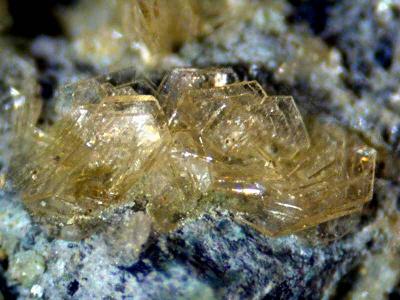

These two images show the more common platy crystals form of susannite with very little develpment of prisum faces.
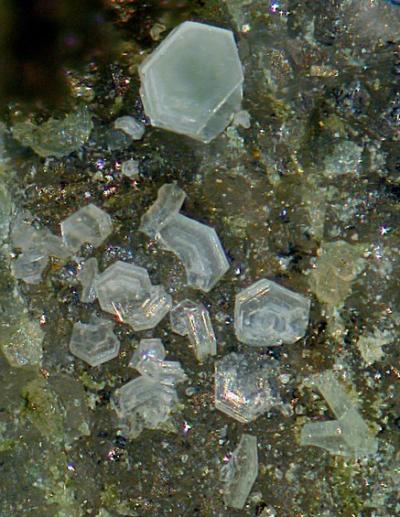
Here simular crystals can be seen,but with more develpment of the prisum faces genarating a tabular habit .
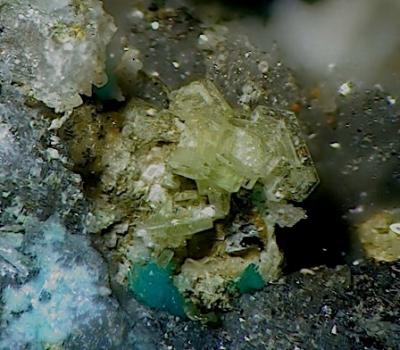
In this image the tabular habit of susannite is seen as a group of crystals, with blue-green areas of caledonite.
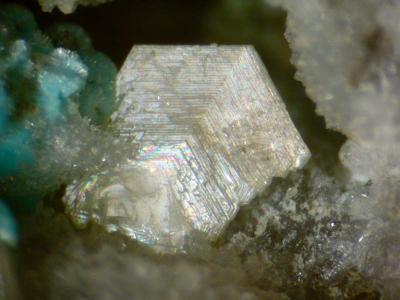

The two crystals in these images show good examples of annular and stepped growth pattens which are another feature of susannite from Frongoch mine.
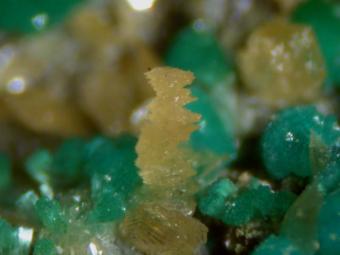
Here the image shows a rare "verticaly" stacked group of platy crystals,with blue-green caledonite.

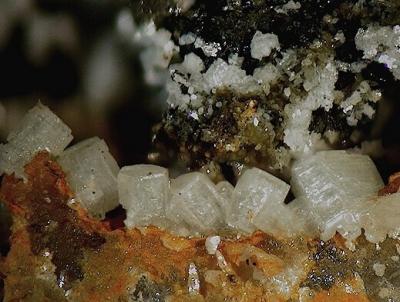
In these two images there has been substantial development of the prisum faces, the crystals appearing to have a barrel-like form.

Rare blue crystals showing major development of the prisum.

Tiny crystsls of susannite showing acicular prismatic habit.
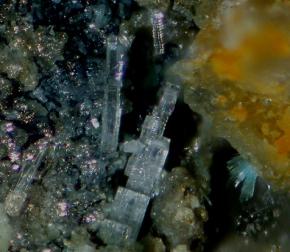

These two images depict prismatic crystals with off sets, whiel the second image probabley also shows oscillatory growth.
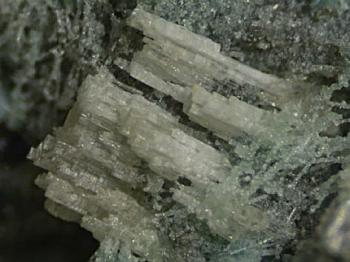
Showing a number of prismatic crystals bundled together, with probable oscillatory growth.
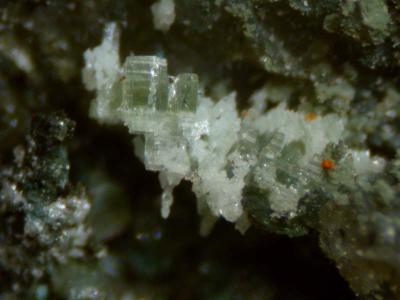

Here the two images show barrel like colour zoned crystals partly over grown by white complex secondary growth of susannite(2).

This image shows the late stage of susannite(2) in its complex crystal habits of oscilatory growth, with prismatic form and off sets.
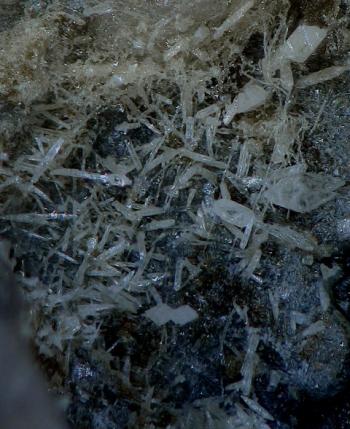
Here can be seen acicular crystals some of which are terminated by trigonal-"rhombic" crystals.

In this image susannite forms scattered balls and small botryoidal groups which show a radial inner structure,
Some of the paragenic seqences noted on specimens collected from Frongoch:-
Cerussite-caledonite-SUSANNITE. Common
Anglesite-caledonite-SUSANNITE. Common
Cerussite-bechereite-SUSANNITE-hemimorphite. Rare
Namuwite-linarite-SUSANNITE. Rare
Namuwite-SUSANNITE(1)-SUSANNITE(2). Very rare
Bechererite-linarite-SUSANNITE. Extremally rare
Cerussite-redgillite-SUSANNITE. Extremally rare
Namuwite-bechererite-redgillite-SUSANNITE(1)-SUSANNITE(2)-hydrocerussite. Extremally rare
Schulenbergite-SUSANNITE-wroewolfeite. Extremally rare
Cerussite-hemimorphite-namuwite-bechererite-hemimorphite-SUSANNITE. Extremally rare.
 YueGongAnBei 44051102000467
YueGongAnBei 44051102000467


 |
|